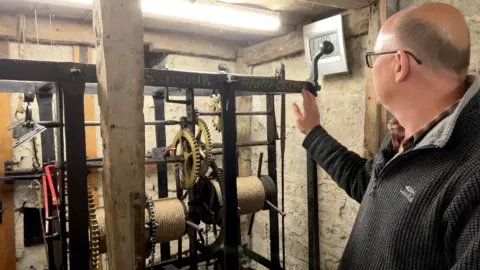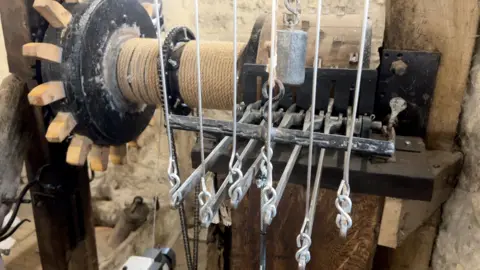Clock still keeping village on time after 500 years
 BBC
BBCVillagers have been celebrating the 500th birthday of the clock in their parish church.
The timepiece in East Hendred, near Wantage in rural Oxfordshire, is believed to be one of the oldest clocks in Britain still in its original location.
With no clock face or hands, it relies on the church bells in the tower at St Augustine's to ring out the time every quarter hour.
The decision to install it in the church was taken when Henry VIII was on the throne, explained the man responsible for St Augustine's bells, Tower Captain Nigel Findley.
"Imagine the excitement that would have caused then," he said.

As well as striking the bells every quarter hour, a carillon resembling the insides of a giant musical box, plays a tune called Angel's Song four times a day, every three hours, starting at 09:00.
In 2015, one of the hammers used to strike the six bells came away and fell into the mechanism, jamming it and silencing the clock.
"It was like missing a friend," said church council secretary Ann Pappenheim. "It's a real part of living in the village.
"When you're working in the garden, it really does give you a sense of time and I missed it," she added. "Now it's back and it's wonderful."
The clock, which was originally built a few miles away in Wantage, underwent a lengthy renovation.
A modification also saw the installation of a mechanised winding system, ending the requirement for somebody to climb the narrow, winding staircase each day to the clock room to do the job by hand.

This week, to mark the clock's birthday, people were able to visit the tower to see the mechanism in action.
Acting as guide was Simon Gilchrist, who led the restoration.
He described it as being "a real passion," to have spent time on the project.
"It's not often that we as clock repairers get the opportunity to work on something that is old, but also something that is of great historical importance," he said.
The clock used to be set using a sundial on the outside of the tower. Now a modern digital clock secured to the wall, next to the Tudor era mechanism is used.
"When this thing was made 500 years ago, we didn't have the accuracy that we have today," said Mr Gilchrist.
Parts of the mechanism like the pendulum expand in the summers heat and contract in the cold of winter, all affecting timekeeping.
This was a device built for a time when peoples' days began at dawn and ended shortly after the sun went down.
Given that, he added: "In terms if accuracy, it's pretty accurate."
You can follow BBC Berkshire on Facebook, X (Twitter), or Instagram.
